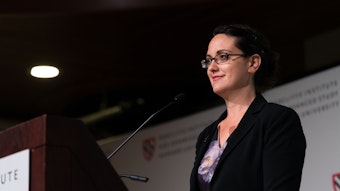This Is Your Country on Drugs

For Liz Chiarello, the recent surge of litigation against several major pharmaceutical companies, including OxyContin maker Purdue Pharma, hasn’t come anywhere close to addressing America’s opioid epidemic, a crisis that has claimed hundreds of thousands of lives and destroys more every day.
The numbers are staggering. According to the US Centers for Disease Control and Prevention (CDC), more than 700,000 people died of drug overdoses between 1999 and 2017. Approximately 68 percent of the more than 70,000 drug overdose deaths in 2017 involved an opioid. On average, 130 Americans die every day of an opioid overdose.
But no number—or lawsuit—tells the whole story. People fighting substance abuse who have been neglected or rejected by the health care system often turn to the street to feed their addiction, notes Chiarello, a Radcliffe fellow and a professor of sociology at Saint Louis University. Most overdose deaths are caused by the illegal opioid heroin or its much more potent cousin, fentanyl, rather than by drugs produced by pharmaceutical companies like Purdue, she adds.
Similarly, stricter prescribing guidelines for primary care physicians can force long-term pain patients to go without their medications. In 2016, the CDC, eager to reduce opioid abuse and overdoses, encouraged doctors to lower doses. But the new standards caused a backlash among providers. Last March, more than 300 health care professionals sent a letter to the agency charging that its recommendations had “led many health care providers to perceive a significant category of vulnerable patients as institutional and professional liabilities to be contained or eliminated, rather than as people needing care.”
In her fellowship talk in October, Chiarello described a multifaceted disaster, citing limited treatment options, a punitive approach to addiction, a drug policy that criminalizes the poor and people of color, a confluence of pain and addiction crises, and poorly resourced and trained physicians. “The overdose crisis is both a devastating tragedy for those whose loved ones are caught in its grip and a constructed social problem, one shaped by institutional power dynamics that affect how we define, elaborate, and respond to this issue,” she said. “In other words, the so-called opioid crisis and our approaches to confronting it are distinctly cultural phenomena.”
Her own response involves examining how the roles of those tasked with addressing different aspects of the crisis are shifting, for better and for worse, as a consequence of emerging technology, interprofessional relationships, and organizational pressures. At Radcliffe, this project has taken the form of a book based on her decade interviewing workers in health care and law enforcement about their use of prescription drug monitoring programs, or PDMPs, and how such programs are changing professional roles and channeling patients in need of help into “dangerous markets.”
In a conversation in her Radcliffe office, Chiarello recalled that she landed on her opioid research almost by chance. In 2009, as a PhD student at the University of California, Irvine, she was interviewing pharmacists for her dissertation, asking them to describe the most pressing ethical issues they faced at work, when she noticed a pattern in their answers.
“I was interested in how their legal, political, and organizational environments were interacting with their own personal beliefs to shape their decision making,” said Chiarello, who expected emergency contraception to be the most frequently cited challenge. “I interviewed 100 pharmacists in four states, and across the board, they said opioids.”
Supported by a five-year, $500,000 National Science Foundation CAREER award, the research behind Chiarello’s book project captures the important role played by pharmacists, police, and other members of the “street-level bureaucracy” in responding to the epidemic. “They’re the ones interacting with the client in the day to day,” she said. “They’re the ones who actually decide whether or not to give resources to a person, whether or not to punish someone. And so they actually have an extraordinary amount of power.”
Before the broad adoption of PDMPs, much of that power derived from what pharmacists described to her during the 2009 interviews as “red flags” and “gut feelings” that stopped them from filling a script. Eager to understand whether they were “making decisions based on cultural stereotypes,” Chiarello reinterviewed those pharmacists over the past decade, along with a new group of pharmacists, physicians, and law enforcement agents in California, Florida, and Missouri.
She found that as PDMPs have become more common, pharmacists have relied on them more heavily to make decisions about patient care. This data might help to reduce inequality in access to care, but red flags and gut feelings still matter for the role they can play in motivating pharmacists to check PDMPs in pharmacies that do not require them to do so.
While prescription drug monitoring programs may seem like a 21st-century invention, the first such initiative was introduced more than 100 years ago, in 1918, when New York State launched an effort to track legal prescriptions of cocaine and heroin that officials feared were contributing to a growing problem of addiction. In subsequent decades, other states adopted similar tools based on paper prescription forms. In the early 1990s, electronic systems were implemented. Today, 49 states, the District of Columbia, and the US territory of Guam have adopted legislation authorizing the use of a PDMP. (Missouri, Chiarello’s home state, remains the exception.) During the past decade, the systems have been upgraded and streamlined. Reports containing head-spinning Excel spreadsheets have been replaced by easy-to-read charts that capture a range of information, such as a patient’s opioid overdose risk score or how many benzodiazepines someone has received in the past month. To Chiarello’s dismay, a handful of PDMPs have also begun incorporating arrest records.
“Part of my work is really problematizing this technology and arguing that we’re turning our health care providers into enforcement agents,” she said, noting that race, class, and gender influence access to pain medication and addiction treatment, arrest rates, acceptance into drug courts, and prison sentencing. “When health care providers are more concerned about drug diversion than about patient well-being, they respond by cutting patients off or contacting law enforcement. Both approaches channel patients out of the health care system into a risky illicit market and expose them to inequality in the criminal justice system.”
In 2011, Chiarello returned to California to conduct interviews with a subset of her initial participants and groups of other professionals. She visited Missouri in 2014 and Florida last year to carry out interviews and data analysis. In each state, she drew from two large, well-resourced counties and spoke with police officers, federal agents, fraud investigators, local and federal prosecutors, chain and independent pharmacists, and physicians in primary care, emergency medicine, and pain management. She then broke the results into four interrelated processes—technological expansion, technological encroachment, transformation, and channeling.
Broader adoption of PDMPs and their increasingly sophisticated analytics have enabled law enforcement agents to do their work in more-effective ways, Chiarello found. For instance, information indicating a Dr. Smith is the highest prescriber of opioids in San Francisco might have raised concern among officers in the past, but today that information in the PDMP is combined with a note that Smith is an oncologist who treats patients experiencing severe pain.
“The PDMP lets officers move on to a podiatrist who might have similar prescribing practices but who raises more concerns because of his professional expertise,” said Chiarello.
At the same time, this technological expansion has led to technological encroachment, she says. “This tool, created to keep track of people who have broken the law, carries with it punitive, enforcement logics. So when health care providers use the PDMP in their day-to-day work, they begin to accept those logics as a taken-for-granted part of their practice.”
And this development, she argues, is driving professional transformation, the process by which health care providers start to act like enforcement agents. In Chiarello’s interviews with pharmacists before they adopted a PDMP, they repeatedly told her that they were “not in the police business” and that when they interacted with a patient who raised concerns, they would simply tell the person the desired drug was “out of stock.”
“Now they’re much more likely to say to the patient, ‘I looked you up in the PDMP, and I see you went to these other doctors and to these other pharmacies and you have a number of pills in your possession, so it doesn’t make sense for me to dispense this to you,’” Chiarello said. “That answer isn’t just about sharing drug data with the patient. It’s also about indicating to the patient they are under surveillance and that they may not want to come back to that pharmacy again.”
Pharmacists have told her that they increasingly see their role as helping “monitor the drug supply.” Meanwhile, law enforcement officers report seeking tips from pharmacists on people who might be “doctor shopping” for multiple prescriptions.
Chiarello considers the fourth process the most harmful. Channeling, as she describes it, is the process by which a patient is pushed from the health care system to the criminal justice system. Direct channeling involves intervention by law enforcement in response to a call from a health care provider. More common—and more concerning, Chiarello says—is indirect channeling, when providers and pharmacists refuse to prescribe or dispense regulated prescription drugs.
“Channeling exposes patients to dangerous, unregulated, illicit markets that carry a far higher likelihood of injury and overdose,” she said. “And providers who refuse care or pharmacists who refuse to fill a script because of what they read in the PDMP are pushing people toward these risky markets while sacrificing an opportunity to help a sick patient.”
The changing professional landscape is not without bright spots, Chiarello says, pointing to lifesaving work done by police and firefighters carrying the overdose drug Naloxone, or Narcan, and efforts in jails and prisons across the country to administer medications for addiction treatment. “I think those are good programs, and I think that they are important,” she said. “But they are not enough.”
Rather than the last resort of criminal justice solutions, Chiarello says, more people with substance abuse disorders should get the help they need from the health care system, and from professionals among the best equipped to help someone struggling with pain or addiction: pharmacists.
“Instead of asking police officers to do things they are not trained for or equipped to do, we should ensure that every pharmacist is available to give patients a warm handoff to treatment,” she said. “Pharmacists are the most available and yet the most underutilized health care providers. Can you name another provider you can just walk up to and talk to within five minutes who has six years of training, significant clinical experience, and who is often there 24 hours a day? There is no other provider like that.”
Chiarello thinks policymakers need to expand Medicare and Medicaid and fortify treatment for mental health and substance abuse issues. A “single-payer system could go a really long way toward building that infrastructure,” she said. She sees PDMPs as a useful tool when applied and monitored in the right way, but she worries about patient privacy and the role of private companies in handling the data. She also warns that linking PDMPs to a person’s criminal history can promote discrimination.
“When we allow a private corporation to do the analytics for the PDMP and let them decide what counts as dangerous, we are allowing this outside corporate entity to shape health care providers’ decision making,” she said. “And as we link it to markers like arrest records, which are racialized and classed, we run the risk of further exacerbating race and class inequality in the health care system.
“Today, we are giving our health care providers enforcement tools while giving our enforcement agents health care tools. This blurs boundaries between care and punishment without effectively addressing the problem. We could be doing so much more.”








